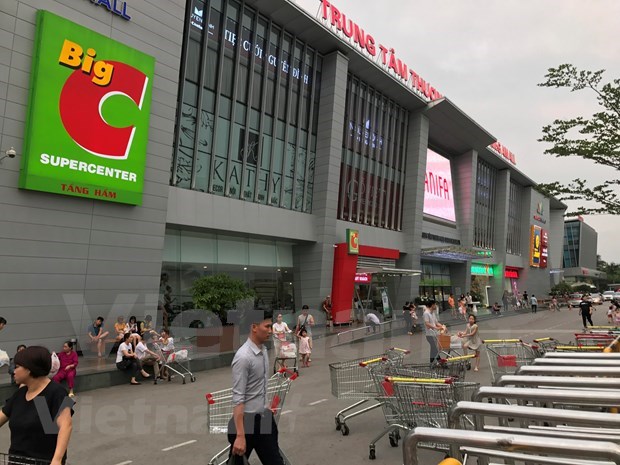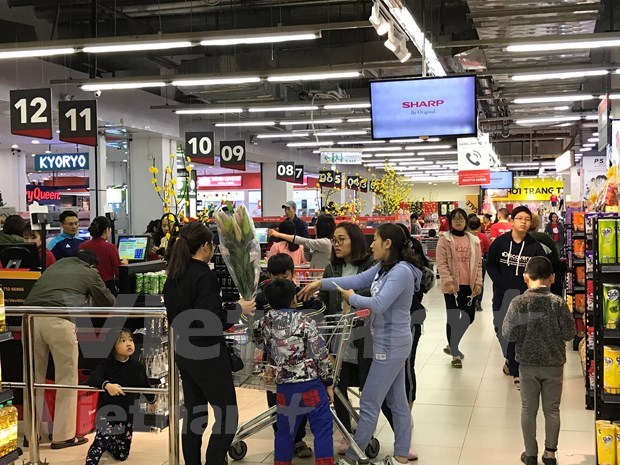FDI businesses focus on Vietnam retail sector
 Big C is one of the FDI corporations gaining foothold in the Vietnam market (Photo: Vietnam+)
Big C is one of the FDI corporations gaining foothold in the Vietnam market (Photo: Vietnam+)Hanoi (VNA) - The retail market in Vietnam in recent years continues to be active with many mergers and acquisitions as well as strong growth in the size of domestic and foreign enterprises.
Statistics released by the General Statistics Office show that retail sales in 2018 were estimated at 3.3 million billion VND, an increase of 12.4 percent compared to 2017.
Notably, according to Le Viet Nga, Deputy Director of the Domestic Market Department (Ministry of Industry and Trade), many large foreign enterprises still consider Vietnam's retail industry to be an attractive investment destination and they are mulling over expanding their investment scale and market share.
Vietnamplus has an interview with Ms. Le Viet Nga to provide a better understanding of the retail sector and orientations from the state agencies to create a level playing field, helping businesses grow together.
- What have been outstanding features in the Vietnamese retail market recently?
Ms. Le Viet Nga: Vietnam's retail market has a great potential for growth due to its large population which reaches approximately 100 million.
Notably, 60% of the population are aged 18-50, the shopping age. Additionally, household spending is forecast to increase by 10.5 percent/year on average and will reach 714 USD / month by 2020, in which the coverage of Vietnam’s modern retail system remains lower as compared to other countries in the region but shows its rapid growth.
Recently, it can be seen that the retail market has had a strong development due to the economic recovery and it is on track to regain a high growth rate. The number of enterprises is increased. Production was recovered so the products supplying for retail were also on the rise.
The results of improving the business investment environment as well as increasing foreign investment in the retail sector are increasing.
It can be seen on the modern retail channel, Saigon Co.op is leading in terms of revenue in 2018, reaching approximately 32,000 billion VND; Vinmart and Vinmart + are also leading in presence which has reached 63 provinces and cities. There are now more than 100 Vinmart supermarkets, along with 1,700 Vinmart + and 66 Vincom centers.
Regarding foreign-invested distribution, the leading retailer remains Big C with 36 supermarkets in Vietnam, expected to increase to 40 supermarkets in 2019. Thanks to its sales programs for local products and specialties, Big C's sales were half that of Saigon Co.op.
Notably, under the campaign "Vietnamese people give priority to using Vietnamese goods" launched in 2009, the proportion of Vietnamese products in traditional and modern retail distribution channels is increasing.
For example, in the first years of implementation of the campaign, the proportion of foreign goods accounted for 60-70 percent and now the situation has changed. In Big C and Saigon Co.op stores, the value of Vietnamese goods accounts for over 90%, while in other shopping centres, the proportion of Vietnamese goods accounts for 70-80%.
 Ms. Le Viet Nga, Deputy Director of Domestic Market Department, Ministry of Industry and Trade (Photo: Vietnam+)
Ms. Le Viet Nga, Deputy Director of Domestic Market Department, Ministry of Industry and Trade (Photo: Vietnam+)- How do you assess the growth of convenience stores over recent time?
Ms. Le Viet Nga: Recently, convenience stores have grown very quickly, especially in big cities with high population density, creating a well-developed market.
In Japan, where population and consumption culture is similar to that of Vietnam, there is a convenience store every 500 meters.
In Vietnam, many domestic and foreign businesses have recently invested in expanding convenience stores, led by Vinmart with 1,700 stores by the end of 2018 and expected to increase to 4,000 nationwide.
Meanwhile, Saigon Co.op and many other business systems are also starting to expand their business in convenience store chain.
- Do you think the rapid development of convenience stores is considered ‘too hot’?
Ms. Le Viet Nga: In my opinion, this is not the issue of whether it is developing excessively or not. The development depends on the market. Within 3 months, if the operation is ineffective, the business will certainly close. Otherwise, with positive growth, perhaps the market is on the right track.
- Amid the rapid development of convenience stores, how do you forecast about traditional retail channels?
Ms. Le Viet Nga: In my opinion, these are two different segments. Traditional markets are places with a variety of goods, where consumers can buy not only necessities but also popular products like condiments and spices. Plus, it is an opportunity for communication. The traditional markets are also places of cultural exchange.
If consumers prefer going to the market to bargain, communicate and talk to others, they will choose to go to the traditional market. For example, a convenience store is limited to 1,000 items then in the traditional market can, the volume be up to tens of thousands.
In addition, convenience store prices may be higher than those in traditional markets, and they are generally at average or above segment. Customers of convenience stores wish to buy popular brands or products with traceability. The presence of convenience stores is going up with the standard of living and income of the people.
 Vinmart and Vinmart + are leading in terms of coverage in 63 provinces and cities (Photo: Vietnam+)
Vinmart and Vinmart + are leading in terms of coverage in 63 provinces and cities (Photo: Vietnam+)- So how does the Ministry of Industry and Trade forecast convenience store segment?
Ms. Le Viet Nga: The Ministry of Industry and Trade is moving in the direction of expanding to attract both domestic and foreign investment in this field as this is a channel with many advantages compared to many other distribution channels. It is suitable for urban lifestyle where people can shop in one place and avoid traffic jams when having to go shopping far away. It also a solution for some environmental and waste problems caused by traditional markets.
This is a new expansion model, which, through Decree 09/CP issued in 2018, highlighted that the convenience store and supermarket below 500 meters will not have to apply ENT in order to attract foreign investment.
- Thank you./.












